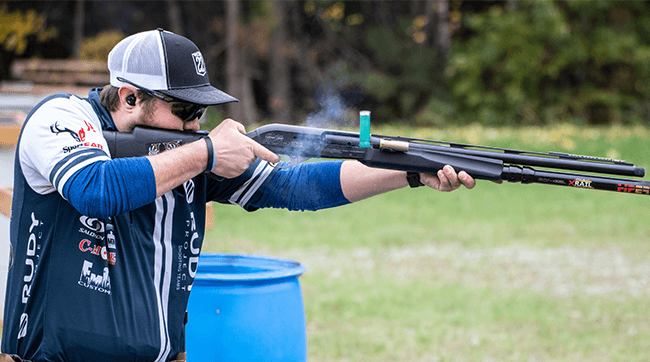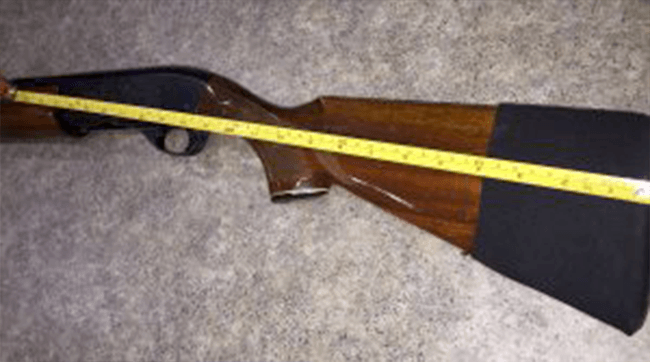Shotgun Fit — A Key Component to Shooting Success
In a word, shotguns are awesome to shoot! They are just so versatile. Whether you’re looking for something when the wolf huffs and puffs at your front door, a short- to medium-range deer stopper, a tool for bringing home a pheasant dinner or one with which to enjoy a round or two of sporting clays, a shotgun will get the job done in style.
As useful as the shotgun is, far too many shooters miss out on its value because they fear it rather than welcome it. Often, this is the result of a poor introduction that includes an ill-fitting gun and too strong of a load. Let’s talk about why a better introduction can go a long way toward making the shotgun one of your favorite firearms.
To shoot a shotgun well you need two things, a consistent mount to the shoulder and cheeking of the gun, and a shotgun that shoots where you look. Now, “shooting where you look” may sound like an odd statement, but remember, most shotgunning involves shooting where the target is going to be (so you most often shoot in front of a moving target), rather than aiming directly at it. Yes, there are exceptions, such as those times when a shotgun is used for deer or turkey hunting, home-defense and in some 3-Gun competition stages, but shotguns are used the majority of the time on moving targets. To connect with a moving target successfully — which involves getting the gun to your shoulder and cheek and swinging the gun’s barrel or barrels in line with the path of the target, the gun has to fit the shooter properly.
In this video, Gil Ash of OSP Shooting Schools explains what the three key measurements gunfitters consider when properly fitting a shotgun. Does your shotgun fit? Find out how you can tell.
Bad Fit vs. Good Fit
Shooting a poorly fitting shotgun can result in a variety of problems, including a bruised shoulder, arm and cheek. Those things in particular are what often happen with those who are given a poor introduction to the sport with an ill-fitting gun. Bruises go away, but the bad impression doesn’t. More importantly than those problems, though, is that a badly fit shotgun can be downright unsafe.
How? A shotgun too long in the stock can get caught in clothing during the gun mount. One too short in the stock comes to the shoulder too quickly, and you’ll feel cramped up, your hands too close together to swing naturally, which means you’ll miss (and you’ll often end up with a bruised cheek). One with barrels too long or with an overall weight that’s too heavy becomes awkward and unwieldy with a small-statured shooter, and if you can’t correctly and safely handle a shotgun because of either of those issues, you’re a potential danger to yourself and others.
Bottom line is that a badly fitting shotgun doesn’t feel good, doesn’t feel natural between your hands or when mounted on your shoulder and ready to be fired. The best example I can think of to really explain this natural feel is to ask you to imagine that you’ve gotten into your car after someone else has been driving it. You would immediately feel the difference if someone had moved the driver’s seat up or back — even just an inch or even half. Sure, you could still drive the car and reach all of the controls, but the bad fit would nag at you. The same is true of the comfort of a properly fitting shotgun.

As a rule of thumb, the proper length of pull when the gun is mounted, positions the shooter’s nose 1.5 to 2 inches from the shooter’s thumb as he/she grips the wrist of the stock. As a minimum, you’ll need at least an inch.
When searching for a shotgun that fits you or having one modified for your comfort level and safe, reliable handling, remember that you always want to fit the shotgun to you, not modify how you shoot to make the shotgun work. For a few tips on getting your shotgun fit right, I contacted a longtime friend at Browning to determine the key point of fitting a shotgun. He told me, “When you mount a shotgun, start by checking the distance between your thumb and nose as you’re looking down the barrel. You’ll need at least an inch. Any less and you’re probably going to suffer some recoil — especially when shooting heavy duck or turkey loads. This will cause your hand to smash into your nose. Most likely it will break your concentration and accuracy at the very least. At worst, it can cause a shooter to recoil and point the muzzle in an unsafe direction or drop the gun.”
Using that guideline as a starting point, when fitting a shotgun (preferably with an experienced gun- and stock-smith, or at least a qualified shotgun instructor who knows how to measure a student for proper fit), there are three specific measurements important in any stock. These measurements are “drop at comb,” “drop at heel” and “length of pull.”
Length of pull is the distance from the middle of the butt (recoil pad) to the trigger. A stock that is too long may catch under the armpit or drag on the lower shoulder during mounting and dismounting. It will feel uncomfortable and awkward and can markedly delay the fast execution of a shot. On the other hand, a stock that is too short may deliver more recoil to the shoulder and cheek.
When considering the length of pull that’s right for you, you should be wearing what you’re wearing when you’ll be shooting the gun. For instance, if you plan to wear several layers for cold-weather shooting, fitting the shotgun without those items while wearing only a t-shirt is asking for trouble. A quick and easy fix for many shooters is to add a slip-on recoil boot for use in warm months when you’re wearing minimal layers, as the boot naturally increases stock length. Those shooters then remove the boot in the cold months to compensate for their extra clothing.

Here is an easy way to measure the length of pull on a shotgun. Lay a tape across the buttstock to the trigger. Remember, the actual measurement of the length of pull is the distance from the middle of the trigger to the end of the gun’s buttstock.
Drop at comb has to do with a shotgunner’s sight picture. Since most shotguns have no rear sights, the shotgunner sights along a plane from breech to barrel muzzle to focus on the target. In effect, the shooter’s eye is the rear sight. Thus the amount of drop at the comb is extremely important in its effect on good or poor shooting. Should the comb be too low, the shooter’s eye will be too low when the gun is properly cheeked, and the gun will throw the charge below the mark. If the comb stands too high, the impact of the charge will consistently be above the target. In addition, the shooter must place his or her cheek against the comb of the stock at the same spot and in the same manner on each successive shot, otherwise the shooting will be erratic, sometimes pointing under the target and at other times over.
The drop at heel measurement is just as important to good shooting as the drop at comb. It contributes a great deal to proper gun alignment with the shooter’s body and, if excessive, will cause the recoil to be more noticeable. A 1 5/8-inch drop at the comb and a 2½-inch drop at the heel will prove correct for at least 95 percent of shooters.
There are other nuances to gun fit, things you’ll pick up as you spend more time with a shotgun on a clays range or hunting wild birds. For instance, trap and skeet guns usually have a straighter stock, which means less drop at both the comb and heel. This is because the target is small and generally taken while they’re rising. With a straighter stock, there is less risk of shooting under the birds seen in this game. There are also the terms “cast on” and “cast off” which have to do with the way the toe of shotgun’s buttstock (the toe is the bottom of the recoil pad, while the heel is the top) is cast left or right to better fit the pocket in your shoulder where the buttstock sits when your arms are raised in the position to shoot the gun.
You may even hear a professional gun fitter or serious competitors talk about “bending” a stock, a complicated process that involves treating the wrist of the stock with heat and oil to actually bend the buttstock at the “wrist,” the place you grip the shotgun with your shooting hand, to better align the stock and barrel/s to a shooter’s individual physique. But get the big three — length of pull, drop at comb and drop at heel — correct, and you have the foundation for a gun that is comfortable to shoot, easy to shoot and safe to shoot.
Properly fitting a stock is an art — just ask any good shooter. Once you have a gun fitted for you, shoot it for several months, perhaps even a year, before making other changes. A well-qualified and reputable shotgun fitter should ask you come back for a tune up in six months to a year to complete a fitting. It is not uncommon, especially with a newer shooter, that they are encouraged by the fitter to be instructed on improving their mount during this trial time. Do not be offended; this is good advice and certainly to the benefit of your shooting. Once your mount is stabilized, the stock fitter will be ready to make the final adjustments (or start over as the case may be). Either way, you will be ready for success.